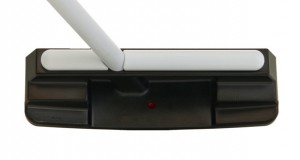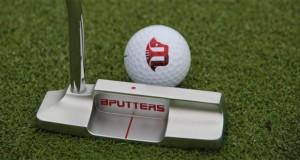 When he unveiled his first Heavy Putter three years ago, Stephen Boccieri introduced a new paradigm to the world of putting: a creation that outweighed—and some would say outsmarted—the traditional putter. The genius of the Heavy Putter system lies not merely in its heavier putter head, but in the weighted shaft insert that provides balance and stability to the stroke.
When he unveiled his first Heavy Putter three years ago, Stephen Boccieri introduced a new paradigm to the world of putting: a creation that outweighed—and some would say outsmarted—the traditional putter. The genius of the Heavy Putter system lies not merely in its heavier putter head, but in the weighted shaft insert that provides balance and stability to the stroke.
Today, Boccieri is poised to release his second generation of Heavy Putters, which enhance the existing Heavy Putter technology with striking new designs and added performance features (click here to read PutterZone.com’s exclusive look at the next generation of Heavy Putters, which will be released this fall). Boccieri is a scratch golfer, a self-proclaimed equipment junkie, and a former mechanical engineer for one of the world’s largest petrochemical and nuclear industry engineering companies, where he specialized in the design of piping systems for nuclear power plants. When discussing his putters, Boccieri speaks in a rapid-fire cadence that belies an intense passion for solving problems, creating solutions and unraveling what he calls the “myths of golf.” PutterZone.com recently caught up with Boccieri to learn about his latest adventures with the Heavy Putter, as well as what to expect next from Boccieri Golf. Following is our exclusive interview:
Word has it that there’s some excitement in the air today at Boccieri Golf?
Yes, we are having an exciting morning. I just got four new prototypes that I’ve been working on. They’re amazing. When you do prototyping, you just never know. You can apply all of your great engineering principles and all the things you think are necessary, but you just never know. I’m very pleased today.
We have been requested to incorporate Heavy Putter technology into some of the more traditional designs in the industry. Along with tradition, I have incorporated features that I believe will enhance the design. Being who I am I can’t just copy designs of the past and turn them into Heavy Putters. So I’ve created some very interesting stuff that’s somewhat traditional in look, but that is also really terrific in terms of optics, feel and MOI.
 In layman’s terms, how does the average golfer benefit from using the Heavy Putter compared to a standard putter?
In layman’s terms, how does the average golfer benefit from using the Heavy Putter compared to a standard putter?
The Heavy Putter simply improves the consistency of the golfer’s stroke.
In addition to your existing Heavy Putter technology, your new putters also feature a deeper, or taller, putter face for a higher center of gravity (CG). Can you explain how you raised the CG—and why it matters?
I have done a few thing to raise the CG of the putters, some more than others. But as a common theme, the height of the putter is increased. Conventional putters are one-inch high with CGs at approximately 0.375 inches. The new Heavy Putter DF (Deep Face) line is 1.25 inches high. This in itself will raise the putter’s CG, regardless of the actual design. On some of the more radical designs I created, I have placed a considerable amount of mass above the center of the putter, moving the CG to above the midway point. For most of the new designs, the CG is landing at about 0.70 inches.
The idea behind raising the CG is to get it closer to the CG or equator of the golf ball, which is 0.84 inches. The theory is to align the CG of the putter and the ball so you can get the best transfer of energy, resulting in more consistent distance control. In order for this to occur with a conventional putter, a golfer has to raise the putter a half inch off the putting surface. This is tough enough to do when the putter is static, and to achieve this vertical impact point consistently during the stroke is virtually impossible. With the new Heavy Putter DF putters, the golfer can concentrate on keeping the putter close to the surface. This enables perfect vertical alignment more frequently, resulting in greater distance control.
I don’t design on aesthetics and let the CG fall where it may. I put the CG where, from an engineering standpoint, I think it needs to be. I then construct the putter around the center of gravity.
All of your putters are face balanced—even the new Anser-style putter, which is unusual. Why is this? (Editor’s note: in a face balanced putter, the center of gravity of the putter head is directly below the axis of the shaft; if you balance the putter on your fingertips and it squarely faces the sky, it is face balanced; if it the toe points toward the ground, it is not face balanced)
It doesn’t make a difference whether it’s a toe-droop putter or a face-balanced putter, a standard putter or a Heavy Putter. A player’s rotation is that player’s fingerprint. It’s almost like the timing and tempo of the swing with a driver.
These are the myths of golf. I’ve been around golf a long time, and I’ve heard them all. The myth that you need a toe-droop putter so that you can play an 8802 like Ben Crenshaw, that he has a swinging door-style stroke…Let me tell you something, I can give Ben Crenshaw a face-balanced putter and his arc will not change one-tenth of one degree. All the belief about toe-droop putters being more accurate than face-balanced putters for people who have more of an arcing stroke is absolutely false.
So, all things being equal, what are the advantages of face balanced?
With a face balanced putter, when you impact the ball on the center of gravity of the face, it’s perfectly in line with the axis of the shaft, so there is zero torsion on the shaft.
When you take a heel-shafted putter that has droop and you strike the ball on the center of gravity of the face, the impact point on the face is roughly three quarters of an inch to one inch away from the shaft axis. This creates torsion. Strike it toward the toe and you’ll understand immediately—you will feel the rotation, and it will feel very unstable.
Watch Tiger Woods and everybody who plays a toe-droop, Anser-style putter. They actually strike the ball on the inside of the center line, and more toward the shaft line. In other words, they are closing the gap from the center of gravity of the putter and the shaft line. That’s one of the myths about where the sweet spot is on toe-droop putters.
Was it an engineering challenge to make an Anser-style putter that is face balanced?
Yes. It was amazing. But the difference in the feel of the putter is remarkable.
Do you view the Heavy Putter as something that every golfer, from Tiger Woods on down, should—and perhaps someday even will—have in their bag?
Yes. We have tested thousand of players and at all levels. The ultrasound testing we do is compelling evidence that almost every player’s results become more consistent when using a Heavy Putter in comparison to their own putter.
What are some of your recent highlights in terms of both retail sales and professional tour usage?
Our records speak for themselves. We have player on most of the major tours globally and have won close to $4 million in prize money. We also have the distinction of being the only putter company to have an official score of 59 on the European Tour. We also have wins on the PGA, Nationwide, European and Canadian Tours.
From a retail point of view, we are very pleased with our progress. We are currently in more than 3,000 accounts across the nation, including all the major golf chains, and we are in 28 countries worldwide.
What can we expect to see next from Boccieri Golf and Heavy Putter?
I have developed new concepts that I believe will launch us deeper into the putter category. If that all works out, I will be developing a driver that I have had on the drawing board for a few years now that will rock the industry.
Thank you, Stephen! Stay tuned at PutterZone.com for more insights into the next generation of Heavy Putters.
 PutterZone – Best Putter Reviews
PutterZone – Best Putter Reviews




Wow Boccieri seems to be one of the guys that evolved the style of playing golf, designing new putters with more hit capacity.